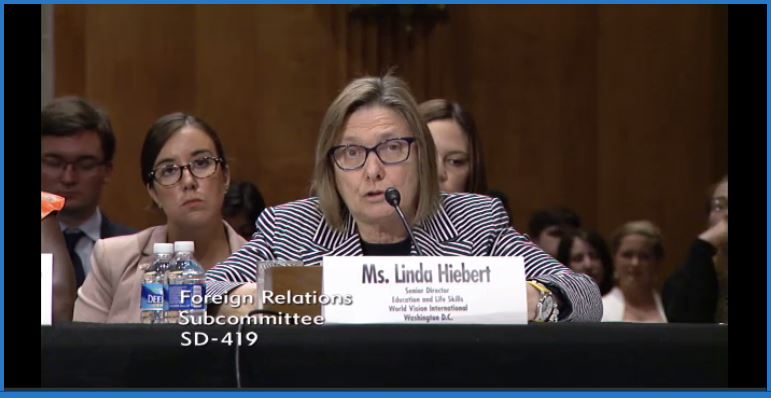
Wednesday, June 15, 2016 – Funding for education should be prioritized in U.S. foreign assistance, including funding that focuses on the barriers to education for vulnerable children in all settings, said Linda Hiebert, World Vision International’s Partnership Leader, Education and Life Skills.
Testifying at the United States Senate on Foreign Relations Sub-Committee hearing, Barriers to Education Globally: Getting Girls in the Classroom, Ms. Hiebert thanked the United States for their support of Education Cannot Wait: A Fund for Education in Emergencies, which was launched at the World Humanitarian Summit in May.
She encouraged further investment in the Development Assistance Basic Education Account at $800 million to ensure the most vulnerable children – including girls – have access to quality education. “Addressing the barriers to education for girls requires a multi-sectoral response,” said Ms. Hiebert.
Globally, one out of every 11 children is out of school. Of the 62 million adolescents out of school, half are girls. In conflict zones, one in four children does not attend school. That number is growing as more and more children’s lives are disrupted by conflict.
Girls living in conflict-affected contexts are twice as likely to be out of school and 90 per cent more likely to be out of secondary school. Despite these staggering trends, global aid for education fell by 10 per cent between 2010 and 2012. Less than two per cent of all humanitarian assistance is spent on education.
“Today I would like to highlight why families struggle to send their daughters to school, whether that is due to lack of access to safe, quality, and affordable education; social attitudes that do not value education for girls; sending girls into the labor market to help support the family; or limited livelihood opportunities for caregivers,” said Ms. Hiebert.
The average length of refugee displacement is now 17 years. As a result, Ms. Hiebert said that the U.S. government must not solely rely on short-term humanitarian financing to support displaced populations.
“In protracted crises, education for displaced children should be integrated into national development assistance plans to strengthen resilience and lessen dependence on humanitarian relief.”
World Vision aims to reach 20 per cent of all affected children when responding to conflict and natural disasters. Prioritizing education and child protection as lifesaving interventions is part of this mandate.
– END –
Full testimony from the hearing, as well as video is available here:
About World Vision:
World Vision is a Christian humanitarian organization conducting relief, development, and advocacy activities in its work with children, families, and their communities in nearly 100 countries to help them reach their full potential by tackling the causes of poverty and injustice. World Vision serves all people regardless of religion, race, ethnicity, or gender. For more information, please visit www.WorldVision.org/media-center/ or on Twitter @WorldVisionUSA.
Highlights
- Globally one out of every 11 children is out of school
- Girls living in conflict-affected areas are twice as likely to be out of school
- World Vision calls for education for displaced children to be included in long-term recovery plans of protracted crises